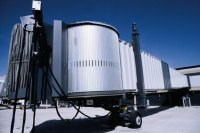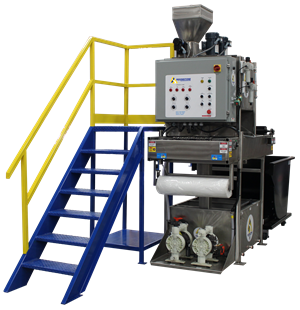How Jetway maintains a weather-resistant finish on its Coating Systems
In 1959, Jetway Systems introduced a revolutionary system that closed the gap between the airport gate and the airplane.
In 1959, Jetway Systems introduced a revolutionary system that closed the gap between the airport gate and the airplane. Rather than board buses, passengers could walk safely from the gate to the airplane via an enclosed bridge. Today, these passenger bridges are common fixtures at airports around the world. Because of the finishing system, Jetway is able to produce bridges that are not only functional, but also aesthetically pleasing and well equipped to withstand the harshest environments.
Making the connection. Based in Ogden, Utah, Jetway operates a 550,000 sq ft plant that fabricates 300 to 500 bridges per year. The company still manufactures its original Apron Drive, Pedestal and Elevating passenger bridges, equipped with a range of options to satisfy customer specifications. It has recently introduced a new truss-style bridge. With the exception of the truss bridge, all are constructed of 14-gauge steel and flange bar stock. The truss bridge is made of square steel tubes and features glass walls.
Taking flight. While travelers must battle long lines, metal detectors and frequent delays, Jetway's bridges have their own list of challenges at airports. Emissions from heavy air traffic generate high concentrations of nitric oxide, which is highly corrosive. This pollutant combined with de-icing salts and relentless exposure to ultraviolet radiation create a hostile environment for even the most flight-worthy coating. To ensure long-term protection from the elements and good color and gloss retention, Jetway worked with Sherwin-Williams' Chemical Coatings Group to formulate an appropriate coating system for the bridges.
The process to create a strong defense for the bridges began in the laboratory. Painting chemists experimented with existing epoxy, urethane and zinc coatings, making minor formulation modifications based on Jetway's performance requirements. Chromate and other hazardous metals were removed and high-solids polymers were selected to meet VOC emission regulations and to create a hospitable work environment for Jetway finishers. Once formulated, the coating system was laboratory and field-tested. Test specimens were put through a battery of performance tests, including direct and reverse impact, mandrel bend and salt fog. After the system was field tested for one year, Jetway inspected the finish to assess its weathering characteristics and found the specially formulated finish to be well suited for the bridges.
Clearing the air. Implementing the EPA-compliant coating system into its finishing operation proved to be an easy transition for Jetway. Using Graco air-assisted airless equipment, the company's finishers apply either a two- or three-coat system, depending on customer specifications. For the two-coat system, a polyamide epoxy primer is applied, followed by Polane H, a urethane topcoat from Sherwin-Williams. When a three-coat system is specified, the application of the epoxy primer is preceded by the spraying of Zinc-Clad VI, which offers extra corrosion protection. Both systems display exceptional corrosion and moisture resistance. In salt-fog tests, the system showed no signs of blistering or rusting even after 5,000 hours of testing, which is well above the industry standard. The urethane topcoat also provides the finishes with excellent depth of color, good gloss retention and superior abrasion and impact strength.
Due to their solid, uniform construction, the Jetway bridges are relatively easy to finish. However, the company's newer truss bridge poses a somewhat greater challenge because the finishing of trusses, much like painting hand rails, creates excess waste and the greater risk for sags and runs. In sprayout tests, Jetway finishers found the new compliant coating system to perform as well. It exhibited good flow and leveling characteristics and was less prone to sagging. Now that the coating has been implemented at the plant, the finishers are also pleased with the air makeup in the finishing area, which contains less odor due to the higher-solids formulation.
Remaining on course. With the successful transition to a compliant finishing system complete, Jetway continues to explore ways to enhance the appearance and performance of its airport bridges. Continuous Improvement sessions are held regularly to discuss everything from surface preparation procedures to spray booth maintenance. Representatives from the paint company and equipment suppliers regularly attend these sessions, providing input on ways to troubleshoot problems. Suggestions made by the finishing suppliers have led to reductions in coating consumption, cost savings from better inventory management and the minimization of hazardous waste. This attention to creating a quality finish has allowed Jetway bridges to remain dominant fixtures at airports around the world.
Related Content
Aerospace Conductive Coating Provides Adhesion, Fluid Resistance
Conductive coating (CM0485115) provides a high-conductivity solution for dissipating static on aluminum and composite aircraft.
Read MoreAnodizing for Bonding Applications in Aerospace
Anodizing for pre-prep bonding bridges the gap between metallic and composite worlds, as it provides a superior surface in many applications on aluminum components for bonding to these composites.
Read MoreMultistage Wash System for Continuous Cleaning Efficiency
Gas-heated conveyor parts washing system is said to provide continuous, efficient cleaning throughout the multiple stages of the system.
Read MoreWastewater Contamination Removal System
Each environmentally beneficial system treats the wastewater stream at a fraction of the cost of larger, more complex industrial systems.
Read MoreRead Next
Education Bringing Cleaning to Machining
Debuting new speakers and cleaning technology content during this half-day workshop co-located with IMTS 2024.
Read MoreDelivering Increased Benefits to Greenhouse Films
Baystar's Borstar technology is helping customers deliver better, more reliable production methods to greenhouse agriculture.
Read MoreA ‘Clean’ Agenda Offers Unique Presentations in Chicago
The 2024 Parts Cleaning Conference, co-located with the International Manufacturing Technology Show, includes presentations by several speakers who are new to the conference and topics that have not been covered in past editions of this event.
Read More















.jpg;maxWidth=300;quality=90)







